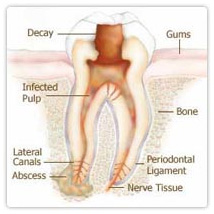
CROWN : This is the part of the tooth you can see above the gumline. It the part of tooth visible in your mouth.
ROOT : This part of the tooth sits in the bone below the gum. The root of your tooth is usually twice as long as the crown, the part you see above the gumline.
The pulp is the living tissue of the tooth with blood supply and nerve supply. Once the dental caries (decay) involves the pulp, the pulp gets infected causing pain. The aim of the root canal treatment is to remove the infected pulp. This is done by removing the infected pulp with dental files in the pulp chamber and cleaning and shaping the root canals and sealing the canal with a filling material.
Each tooth has a soft tissue – the pulp which nourishes the tooth. Because of deep decay, injury, or gum disease, the pulp tissue in your tooth has become inflamed or infected. In any other part of your body, if a similar tissue becomes diseased, the body merely throws it off and forms new tissue. However, a tooth is a unique and different. Because the infected soft tissue (pulp) within the tooth is totally encased within hard tissue, it is the role of the dentist to remove the soft tissue located in the root canals, cleanse the area, and finally fill the canals.
With a special material so that bacteria cannot re-enter the tooth to cause another infection. When the endodontic treatment is complete, the tooth is by no means "dead". It receives quite adequate support from the surrounding tissues and may be expected to last as long as any other natural tooth.
STEP 1:After the tooth is anesthetized, an opening is made through the crown into the pulp chamber.
STEP 2: The length of the root canals is determined.
STEP 3: Unhealthy pulp is removed. Canals are cleaned, enlarged and shaped.
STEP 4: Canals are filled and sealed. A metal post may be added for structural support or to retain restorative materials.
STEP 5: The tooth is sealed with a temporary filling. Usually a crown adds further protection.
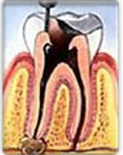
STEP 1
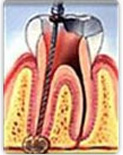
STEP 2
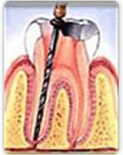
STEP 3
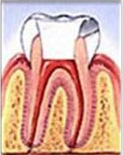
STEP 4
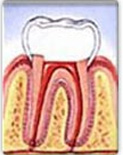
STEP 5
If you have an infection of the pulp, you may not feel any pain at first. But if it is not treated, the infection will cause pain and swelling. In some cases, an abscess will form.
Your tooth might need a root canal if:
To determine whether your tooth needs root canal treatment, your dentist will often place hot or cold substances against the tooth. The purpose is to see if it is more or less sensitive than a normal tooth. He or she will examine the tissues around the tooth and gently tap on the tooth to test for symptoms.
You also will be given X-rays of the tooth and the bone around the tooth. The X-rays may show a widening of the ligament that holds the tooth in place or a dark spot at the tip of the root. If either of these is present, your dentist probably will recommend a root canal procedure.
Root canal treatment can be done in one or more visits. It depends on the situation. An uncomplicated root canal treatment often can be completed in one visit. Some teeth may be more difficult to treat because of where they are in the mouth. Some teeth have more roots than other teeth. Treating a tooth with many roots takes longer. Some teeth have curved root canals that are difficult to find. If you have an infection, you will visit the dentist several times so that he or she can make sure that the infection is gone.
When people are told that they need a root canal treatment, they usually think about pain. However, the pain they feel is caused by an infection in the tooth, not by root canal treatment. A root canal is done to eliminate that pain. The root canal procedure itself is painless. A local anesthetic numbs the tooth and the surrounding area. Many people may be afraid to have a root canal because they are anxious about having dental work done. Dentists can provide calming medicines, such as nitrous oxide.
Many people believe that once they have had root canal treatment, they will no longer feel pain in the treated tooth. This, however, is incorrect. The tooth will no longer be sensitive to hot or cold food or beverages. But for a few days after treatment, the area around the tooth can be sensitive. If this happens to you, your dentist can prescribe a medicine to reduce inflammation.
It is not correct to assume that the treated tooth will eventually need to be extracted. In fact, most root canal treatments are successful and result in the tooth being saved.
The whole point of root canal therapy is to try to save a tooth, not to remove it. Your tooth and roots are not removed. The canals are cleaned and shaped on the inside only. The nerve tissue and pulp are removed along with some of the inside part of the root to ensure all the bacteria have been removed.
Once you have received root canal therapy, you will need to make follow-up appointments to have a permanent filling or crown put on the tooth. The temporary filling that is placed after the pulp has been removed will protect the root from infection for only a short time. A permanent filling or crown must be placed to ensure that bacteria don't leak into the canal.